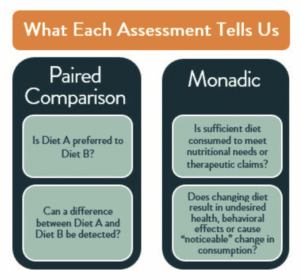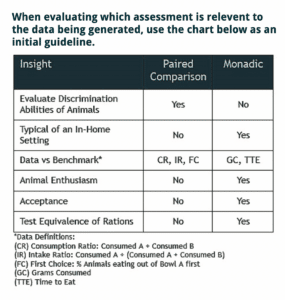OVERVIEW Palatants are flavor enhancers used in pet foods to improve their palatability and increase pet acceptance. Developing an effective palatant involves a systematic approach to selecting the best combination of ingredients that provide the optimal aroma and taste for cats and dogs. However, some ingredients have inherent natural variability...

Paired vs. Monadic
Paired Comparison assessments can tell us something different than Monadic assessments. Paired
Comparison uses two bowls, where two different foods are presented. In Monadic testing, only one bowl of food is presented.
Which one is better? It depends on what question is being asked. The protocols for each assessment
provide different insights and data outputs.
Protocols can be tailored to a customer’s specific need. The following information discusses the general protocols most widely used.

Paired Comparison Protocol
- Test diets are the sole source of food and represent the daily caloric need of each animal
Most commonly 20 animals x 2 days
Bowls are switched to avoid side preference - Fed for a specific amount of time depending on the test
- First choice data collected
- Cats
- RFID system used to measure amount and frequency of consumption
- Dogs
- Food scales linked to a customized program for consumption data analysis
- Both bowls are removed when one is emptied
Monadic Protocol
- Test diet is the sole source of food and represents the daily caloric need of each animal
- Sequential, controlling for order effect
- Day 1 Diet A; Day 2 Diet B; Day 3 Washout (non- testing diet); Day 4 Diet B; Day 5 Diet A
- Provides within-subject, repeated measured data
- Inter-trial washout period (other) may be varied
- Consistency of Consumption, often used for in- home testing
- “X” days Diet A, then “X” days Diet B; where “X” typically varies from 7-30 days
- Only one diet may be fed during this period of time
- Longer testing period typically reflects better in- home setting
- Respondents should be evenly distributed across all products as a starting point so there is an equal opportunity of seeing each of the products first

Knowing what question you are trying to answer or insights you are trying to glean typically points you to the correct assessment. Contact your AFB International account representative to assist you in the decision.